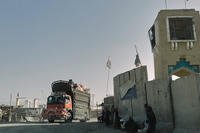The U.S. Air Force does not appear to be studying the possibility of "nuking hurricanes."
After reports that President Donald Trump had suggested the use of nuclear bombs to dissipate hurricanes forming in the Atlantic, an Air Force spokesperson told Military.com that the proposal has not come up recently. The Air Force operates two-thirds of the U.S. "nuclear triad" with ground-launched and air-launched weapons.
U.S. Strategic Command, the unified combatant command responsible for America's nuclear arsenal, would not discuss any interest in employing nuclear weapons against storms, referring all questions to the Defense Department.
The DoD referred all questions on the topic to the White House.
On Monday, Trump denied reports, made first by Axios, that he had asked top Homeland Security and national security officials on several occasions about bombing hurricanes.
Related: Pentagon Wants to Use AI to Predict the Next Wildfire or Earthquake
"The story by Axios that President Trump wanted to blow up large hurricanes with nuclear weapons prior to reaching shore is ridiculous," Trump said via Twitter. "I never said this."
Using nuclear weapons against major storms has been proposed before.
Jack Reed, an Air Force meteorologist during World War II, studied the impact of storms on military operations; in 1959, he proposed firing submarine-launched nuclear missiles into the eye of a hurricane.
Submarines were preferable to using a bomber because a sub crew could retreat deep into the ocean to avoid radioactive fallout, Reed said in his paper, "Scientific Uses of Nuclear Explosions," presented during the Plowshare Symposium in May 1959.
However, many scientists advise against such a move.
“this approach neglects the problem that the released radioactive fallout would fairly quickly move with the tradewinds to affect land areas and cause devastating environmental problems. Needless to say, this is not a good idea,” notes a blog post published by the National Oceanic and Atmospheric Association.
The post goes on to note that the vast amount of energy required to modify the path of a storm system makes the proposal at very least impractical.
While the Air Force may not be in the business of nuking hurricanes, officials are studying how to better prepare for them.
Air Combat Command recently completed two back-to-back studies focusing on better hurricane preparation, as well as how the climate affects the command's day-to-day operations, officials recently told Military.com.
"ACC stood up a Severe Weather Readiness Assessment team [with] the intent ... to support wing commanders to the maximum extent possible to ensure severe weather readiness with a focus on the upcoming 2019 hurricane season and those installations on or near the Atlantic and Gulf coasts," command spokeswoman Leah Garton said. Air Force Chief of Staff Gen. David Goldfein and then-Air Force Secretary Heather Wilson tasked ACC with the study following Hurricane Michael, a Category 5 hurricane that devastated Tyndall Air Force Base, Florida, in 2018.
The assessment looked at ways to safeguard bases, "evacuating the population if they need to, get airplanes out or covered or sheltered," Gen Mike Holmes, head of ACC, said last week during a roundtable discussion with reporters.
Each wing and unit may take different actions "96 hours out, 72 hours out, 48 hours out," before a storm, he said.
"So one of the things [the team] looked at was, 'Can we expand that to take more of a strategic view? Are there things we should do early in hurricane season that will make it easier to do those things?'" Holmes said.
He continued, "We're taking a look at facility construction and what the limiting factors are. I think we learned several things about how to defend against … weather as a threat and treat it like a threat to our operations and how to get further ahead in the planning phase for it."
A second study, dubbed the "ACC Weather Assessment" conducted by the 14th Weather Squadron at Offutt Air Force Base, Nebraska, looked at specific weather and climate threats to installations, according to spokeswoman Alexandria Worley.
Experts from the unit examined data "to determine the prevalence of impactful weather conditions within 50 miles of 12 main ACC bases and two additional bases with a significant ACC presence," she said in an email.
The weather conditions studied included extreme temperatures, droughts, high winds, floods and wildfires, among others. The investigation also took regional weather patterns and location into account.
"Not only does the assessment estimate the frequency of environmental impacts for each installation, but it also reveals regional threat patterns," Worley said.
For example, installations located in the western United States "have a lower incidence of severe weather compared to installations in the Midwest or East," she said.
As part of the long-term study, here's what some bases are already facing, according to the ACC:
- Joint Base Langley-Eustis, Virginia: tropical cyclones, sea level rise
- Seymour Johnson Air Force Base, North Carolina: tropical cyclones, severe thunderstorms, heat
- Shaw Air Force Base, South Carolina: severe thunderstorms, heat
- Moody Air Force Base, Georgia: heat, tropical storms
- Tyndall: tropical cyclones, heat
- Tinker Air Force Base, Oklahoma: severe thunderstorms, floods
- Grand Forks Air Force Base, North Dakota: winter weather, winds
- Offutt: winter weather, severe weather
- Mountain Home Air Force Base, Idaho: wildfires, winter weather
- Hill Air Force Base, Utah: wildfires, winter weather
- Beale Air Force Base, California: wildfires
- Creech Air Force Base and Nellis Air Force Base, Nevada: winds, wildfires
- Davis-Monthan Air Force Base, Arizona: floods, severe thunderstorms
In March, Offutt was hit by floodwaters that damaged multiple buildings and training equipment.
The assessment's analysis "could inform future mitigation strategies and extreme weather preparations at ACC installations," Worley said.
-- Oriana Pawlyk can be reached at oriana.pawlyk@military.com. Follow her on Twitter at @Oriana0214.












